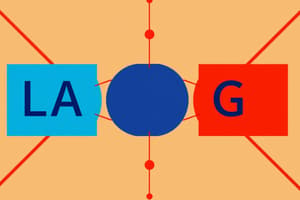Podcast
Questions and Answers
What is the simplification rule?
What is the simplification rule?
A (A'B) = AB; A+(A'B) = A+B
What does the absorption rule state?
What does the absorption rule state?
A (A+B) = A; A+(AB) = A
What is the distributive property in Boolean algebra?
What is the distributive property in Boolean algebra?
A (B+C) = (AB)+(AC); A+(BC)= (A+B)(A+C)
What is DeMorgan's theorem?
What is DeMorgan's theorem?
What does the union operation state?
What does the union operation state?
What is the null element?
What is the null element?
What is the complementary rule?
What is the complementary rule?
What is the involution rule?
What is the involution rule?
What defines the idempotent law?
What defines the idempotent law?
What does the associative law state?
What does the associative law state?
What is the commutative law?
What is the commutative law?
What is the identity element for addition and multiplication?
What is the identity element for addition and multiplication?
What signifies idempotency in Boolean algebra?
What signifies idempotency in Boolean algebra?
What does NAND gate represent algebraically?
What does NAND gate represent algebraically?
What is a maxterm in Boolean algebra?
What is a maxterm in Boolean algebra?
What is a minterm?
What is a minterm?
Flashcards are hidden until you start studying
Study Notes
Boolean Algebra Theorems and Concepts
-
Simplification:
- A (A'B) simplifies to AB.
- A + (A'B) simplifies to A + B.
-
Absorption:
- A (A + B) reduces to A.
- A + (AB) simplifies to A.
-
Distributive Law:
- A (B + C) equals (AB) + (AC).
- A + (BC) equals (A + B)(A + C).
-
DeMorgan's Theorem:
- The expression A'B' transforms to A' + B' (AND to OR).
- The expression A' + B' transforms to A'B' (OR to AND).
-
Union:
- A + 1 results in 1.
- A + 0 equals A.
-
Null Law:
- A * 0 equals 0.
- A + 1 equals 1.
-
Complementary Law:
- A * A' results in 0.
- A + A' equals 1.
-
Involution Law:
- A'' simplifies back to A.
-
Idempotent Law:
- A * A equals A.
- A + A equals A.
-
Associative Law:
- A(BC) simplifies to ABC.
- A + (B + C) simplifies to A + B + C, demonstrating that grouping does not affect results.
-
Commutative Law:
- AB equals BA.
- A + B equals B + A, showing order does not matter.
-
Identity Law:
- A + 0 equals A.
- A * 1 equals A, indicating the identity elements for addition and multiplication.
-
Inverse Law:
- Identifies that the inverse element produces the identity; 0 for OR and 1 for AND.
-
Idempotency:
- Identical inputs in OR or AND gates yield the original value, indicating redundancy.
Logic Gates
-
NAND Gate:
- The operation is represented by (A * B)'.
-
OR Gate with Inverted Inputs:
- Expressed as A' + A'.
-
AND Gate with Inverted Inputs:
- Written as A' * B'.
-
NOR Gate:
- Represented by (A + B)'.
Canonical Forms
-
Sum-of-Products (SOP):
- Consists solely of maxterms, representing a disjunction (OR) of minterms.
-
Product-of-Sums (POS):
- Composed only of minterms, indicating a conjunction (AND) of maxterms.
Minterms and Maxterms
-
Minterm:
- A Boolean expression that results in an output of 1 for a single cell in a Karnaugh map or truth table, outputs 0 elsewhere.
-
Maxterm:
- A Boolean expression that results in an output of 0 for a single cell in a Karnaugh map or truth table, outputs 1 elsewhere.
Studying That Suits You
Use AI to generate personalized quizzes and flashcards to suit your learning preferences.




